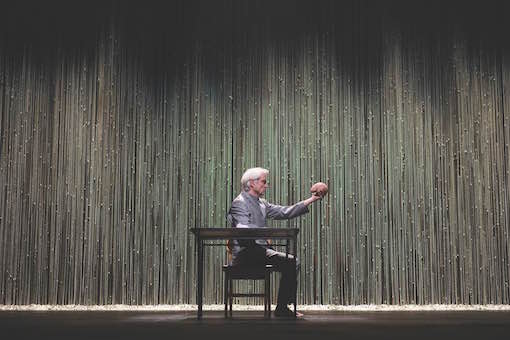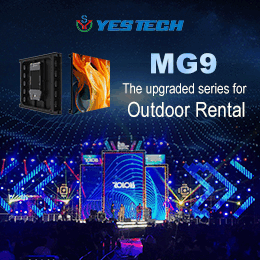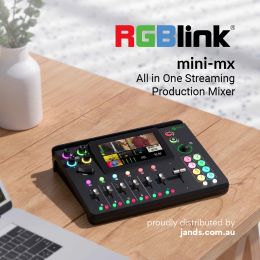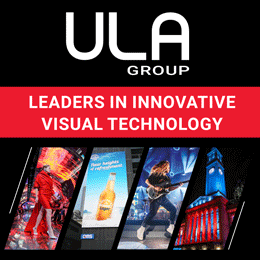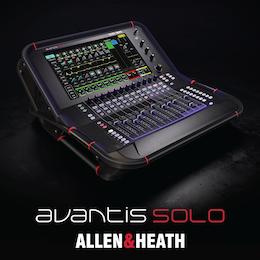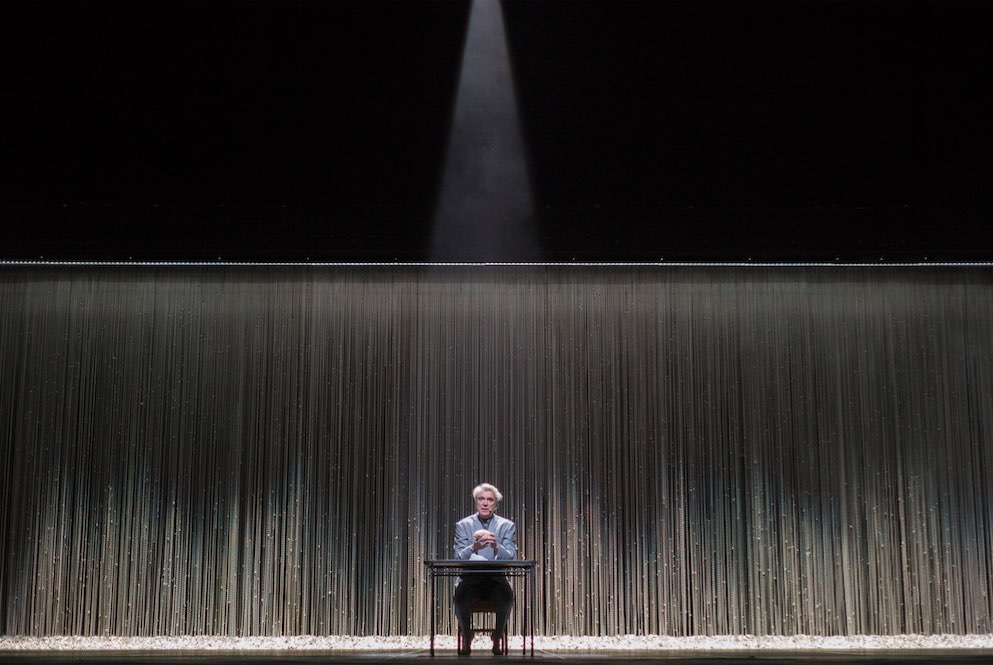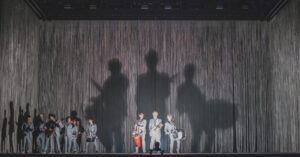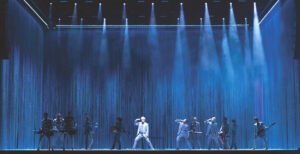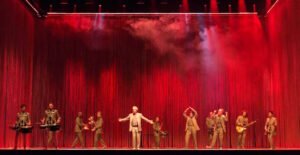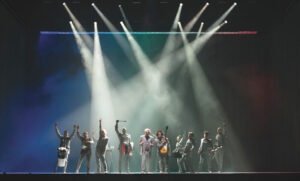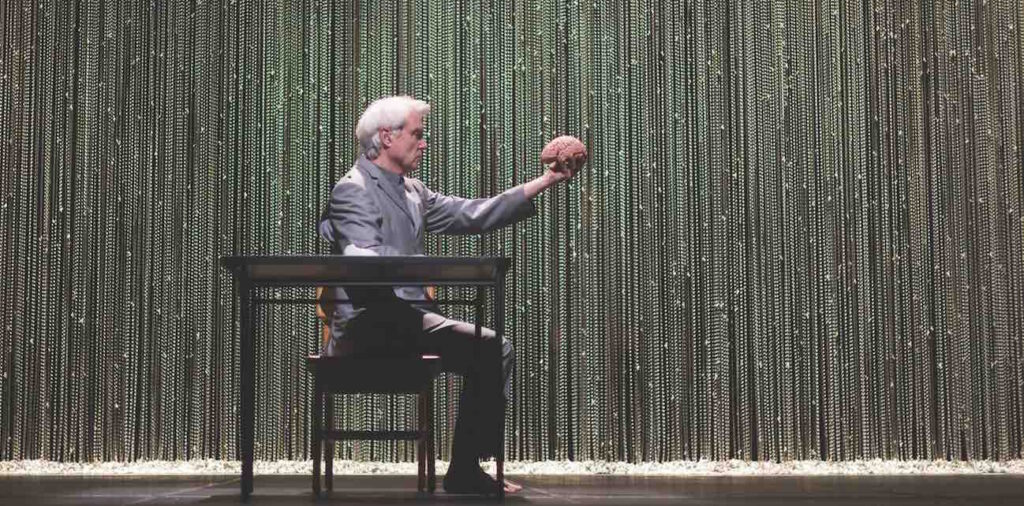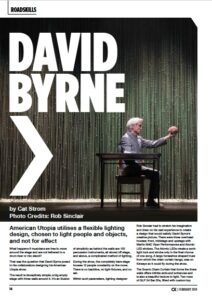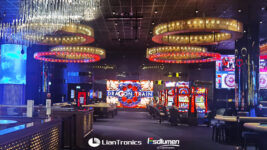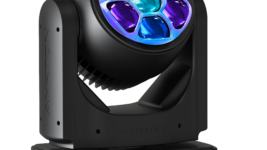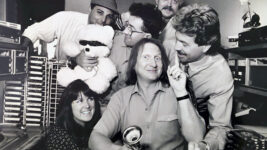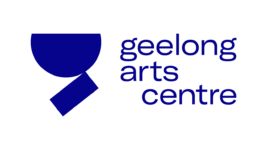Subscribe to CX E-News
ROADSKILLS
David Byrne
by Cat Strom.
Photo Credits: Rob Sinclair.
American Utopia utilises a flexible lighting design, chosen to light people and objects, and not for effect.
What happens if musicians are free to move around the stage and are not tethered to a drum riser or mic stand? That was the question that David Byrne posed to his collaborators designing his American Utopia show. The result is deceptively simple; a big empty stage with three walls around it.
It’s an illusion of simplicity as behind the walls are 150 percussion instruments, all stored off stage, and above, a complicated method of lighting.During the show, the completely bare stage houses 12 people constantly on the move. There is no backline, no light fixtures, and no set.
Within such parameters, lighting designer Rob Sinclair had to stretch his imagination and draw on his vast experience to create a design that would satisfy David Byrne’s creative picture. There were three overhead trusses; front, midstage and upstage with Martin MAC Viper Performances and Atomic LED strobes.
The Atomic LEDs create a work-light look and strobe only in the final chorus of one song. A large horseshoe shaped truss from which the chain curtain hangs, was on Kinesys so it could fly during the show.
The Scenic Chain Curtain that forms the three walls offers infinite exits and entrances and is also a beautiful texture to light. Two rows of GLP X4 Bar 20s, fitted with custom top hats made by Upstaging so you don’t see the source, enable him to light the top and bottom in different colours.
David requested no tricks or light beams moving around, no haze, in fact, no light show per se. The 12 performers onstage are lit by the roof of 66 Martin MAC Viper Performances all running on the BlackTrax tracking system.
“This meant that any light in the rig could be assigned to any person, change any of the parameters to follow them around wherever they go,” said lighting director and associate designer Douglas Green.
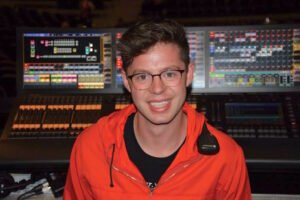
Douglas Green
“Everyone wears the same grey suit for each show into which two BlackTrax beacons are sewn, one on each shoulder. A ‘centroid’ is created between the two trackers which becomes the point that the lights follow.
“The system only needs to see one beacon (they work by line of sight to cameras in the rig) to work but a live backup is necessary in case one goes down or someone flicks their hair over it, for example.”
Douglas admits that it took quite a bit of fiddly programming but fortunately he was working with Sam Augustus, BlackTrax programmer on the road, and Oli Metcalfe who programmed the show initially.
“BlackTrax is incredible but it does add another layer to the programming,” he said. “What’s been really good about it is that it allows us to do things with moving lights that you couldn’t ordinarily do with followspots.
“Without it, we would need 12 truss mounted followspot operators just to get a front light on each person. Plus we have gobos, colour changing and framing – it’s not a followspot replacement, rather a whole new creative tool.”
Also in the rig was a single theatrical ghost light that David holds for one song, a custom made footlight for a song, and two X4 Bar 20s on a boom to the side of the stage which shine through the chain.
With a background in theatre and corporate work, Douglas has enjoyed his foray into concert touring. Having trained as a dancer, Douglas has a keen interest in dance and theatre lighting and he was able to bring those skills to the American Utopia tour, which is essentially a choreographed rock show.
“Obviously it’s Rob’s design but as his associate, having an idea of how people move in space and how to light them has been very helpful,” commented Douglas.
“Chris the backing singer and dancer also operates as a dance captain while we’re out. We talk every day about what’s changed about the rig and the space and how it’ll affect the performance that day.”
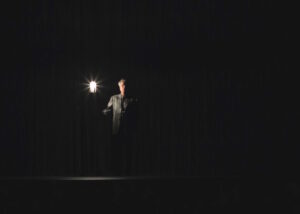 Rob and Douglas worked closely with choreographer Annie-B Parson and David Byrne to collaboratively build the show rather than just apply a lighting design to a band. All the design and production elements are very closely knitted together to create a cohesive piece.
Rob and Douglas worked closely with choreographer Annie-B Parson and David Byrne to collaboratively build the show rather than just apply a lighting design to a band. All the design and production elements are very closely knitted together to create a cohesive piece.
Douglas ran the show on an MA Lighting MA2 fullsize with two NPUs onstage. Again for a show that looks so simple, there are quite a lot of complicated tricks in the programming – subtle video mapping across the X4 Bar 20s create entirely unique looks, and the BlackTrax is a whole new element.
“The lighting is run very much like a theatre show with a cue stack,” explained Douglas. “The set list is not changed often, visual narrative and flow of the show is integral and the changeover of instruments between songs is quite complicated.
“I operate the whole show live — there is no timecode or any sort of triggering. We do however use some features within BlackTrax to deal with some of the potentially impossible cueing challenges.”
From CX Magazine – February 2019. CX Magazine is Australia and New Zealand’s only publication dedicated to entertainment technology news and issues – available in print and online. Read all editions for free or search our archive www.cxnetwork.com.au
© CX Media
Subscribe
Published monthly since 1991, our famous AV industry magazine is free for download or pay for print. Subscribers also receive CX News, our free weekly email with the latest industry news and jobs.


